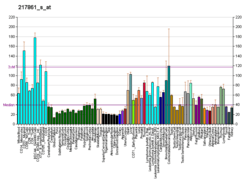PREB
Prolactin regulatory element-binding protein is a protein that in humans is encoded by the PREB gene.[5][6][7]
This gene encodes a protein that specifically binds to a Pit1-binding element of the prolactin (PRL) promoter. This protein may act as a transcriptional regulator and is thought to be involved in some of the developmental abnormalities observed in patients with partial trisomy 2p. This gene overlaps the abhydrolase domain containing 1 (ABHD1) gene on the opposite strand.[7]
References
- 1 2 3 GRCh38: Ensembl release 89: ENSG00000138073 - Ensembl, May 2017
- 1 2 3 GRCm38: Ensembl release 89: ENSMUSG00000045302 - Ensembl, May 2017
- ↑ "Human PubMed Reference:".
- ↑ "Mouse PubMed Reference:".
- ↑ Fliss MS, Hinkle PM, Bancroft C (May 1999). "Expression cloning and characterization of PREB (prolactin regulatory element binding), a novel WD motif DNA-binding protein with a capacity to regulate prolactin promoter activity". Mol Endocrinol. 13 (4): 644–657. doi:10.1210/me.13.4.644. PMID 10194769.
- ↑ Edgar AJ (Jul 2003). "The gene structure and expression of human ABHD1: overlapping polyadenylation signal sequence with Sec12". BMC Genomics. 4: 18. doi:10.1186/1471-2164-4-18. PMC 156608. PMID 12735795.
- 1 2 "Entrez Gene: PREB prolactin regulatory element binding".
Further reading
- Barrios-Rodiles M, Brown KR, Ozdamar B, et al. (2005). "High-throughput mapping of a dynamic signaling network in mammalian cells". Science. 307 (5715): 1621–1625. doi:10.1126/science.1105776. PMID 15761153.
- Gerhard DS, Wagner L, Feingold EA, et al. (2004). "The status, quality, and expansion of the NIH full-length cDNA project: the Mammalian Gene Collection (MGC)". Genome Res. 14 (10B): 2121–2127. doi:10.1101/gr.2596504. PMC 528928. PMID 15489334.
- Ota T, Suzuki Y, Nishikawa T, et al. (2004). "Complete sequencing and characterization of 21,243 full-length human cDNAs". Nat. Genet. 36 (1): 40–45. doi:10.1038/ng1285. PMID 14702039.
- Strausberg RL, Feingold EA, Grouse LH, et al. (2003). "Generation and initial analysis of more than 15,000 full-length human and mouse cDNA sequences". Proc. Natl. Acad. Sci. U.S.A. 99 (26): 16899–16903. doi:10.1073/pnas.242603899. PMC 139241. PMID 12477932.
- Taylor Clelland CL, Levy B, McKie JM, et al. (2000). "Cloning and characterization of human PREB; a gene that maps to a genomic region associated with trisomy 2p syndrome". Mamm. Genome. 11 (8): 675–681. doi:10.1007/s003350010142. PMID 10920239.
External links
- PREB human gene location in the UCSC Genome Browser.
- PREB human gene details in the UCSC Genome Browser.
This article is issued from
Wikipedia.
The text is licensed under Creative Commons - Attribution - Sharealike.
Additional terms may apply for the media files.




